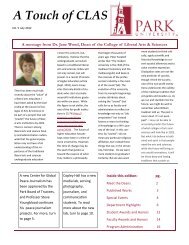How to Write a Radio Serial Drama for Social Development- PDF
How to Write a Radio Serial Drama for Social Development- PDF
How to Write a Radio Serial Drama for Social Development- PDF
You also want an ePaper? Increase the reach of your titles
YUMPU automatically turns print PDFs into web optimized ePapers that Google loves.
xii<br />
Prologue<br />
1. Individual-level communication occurs when people read, write, speak, gesture with their hands or<br />
bodies, listen <strong>to</strong> messages from others, or observe what others are doing. Most theories of individuallevel<br />
communication focus on how in<strong>for</strong>mation is shaped in<strong>to</strong> messages and how those messages are<br />
received, processed, and unders<strong>to</strong>od by others. Theories of individual-level communication consider:<br />
• What does a person say or do<br />
• What sense does a person make of what others say or do<br />
• <strong>How</strong> does a person respond <strong>to</strong> what others say or do<br />
Communication research indicates that everything a person does including food choices, way of<br />
walking, and color preferences communicates something about that person <strong>to</strong> the world. Clothing, <strong>for</strong><br />
example, reveals much about people, including the groups <strong>to</strong> which they think they belong, their selfimages,<br />
and their understanding of their own social status.<br />
While these are all external communication signs, some theories also identify an internal level of<br />
communication that is concerned with the way a person processes ideas and in<strong>for</strong>mation. Internal<br />
communication also indicates a great deal about a person's nature, but it cannot be observed directly;<br />
there<strong>for</strong>e it is usually inferred from what a person says or does. <strong>Drama</strong>tists commonly include external<br />
signs of internal communication <strong>to</strong> indicate what a character thinks or feels and <strong>to</strong> suggest fascinating<br />
aspects of a character's personality. For example, one character might ask another <strong>to</strong> explain some<br />
nonverbal behavior: "Why do you look away from me when I talk <strong>to</strong> you" or "Why are you wringing<br />
your hands"<br />
2. Interpersonal or small group communication takes place between pairs of people (such as a married<br />
couple), within small groups (such as a family or household), or among somewhat larger groups of<br />
friends and strangers (such as a party or community meeting). It always involves some type of a<br />
relationship between two or more people. While individual communication focuses on what "I" or<br />
"you" say or do, interpersonal communication focuses on what "we" say or do <strong>to</strong>gether. This is<br />
affected by such considerations as how long the participants have known each other, how well they<br />
know each other, and what expectations and goals they bring <strong>to</strong> the interaction.<br />
3. Organizational or institutional communication refers <strong>to</strong> the exchange of in<strong>for</strong>mation and messages<br />
within or among organizations and institutions; these may include villages, communities, agencies,<br />
businesses, media, and religious groups. Organizations and institutions are larger than small groups<br />
and tend <strong>to</strong> have an administrative or bureaucratic structure and <strong>for</strong>mal rules. Organizations<br />
communicate by generating reports and letters, holding meetings, making telephone calls,<br />
transmitting faxes, and sending e-mail. They also plan and implement activities, allocate and consume<br />
resources, and undertake other organizational engagements all of which are <strong>for</strong>ms of communication.<br />
An organization's size, structure, resources, power, and position in the community or society influence<br />
the particular ways in which an organization communicates.<br />
4. Societal or cultural communication occurs when there is an exchange and interpretation of symbols,<br />
images, and values throughout a society, usually over an extended period. News media throughout the<br />
world, <strong>for</strong> example, routinely address public concerns about politics, social values, morality, and<br />
religion. What the media say becomes a subject of public debate and private discussion, some of which<br />
is picked up, in turn, by journalists who present it in additional news coverage. This process can shift<br />
or strengthen social and political values over time. Media also can affect social and political values<br />
through non-news programs, such as radio and television dramas. Studies show that people often<br />
expect consciously or unconsciously that they will learn something about how <strong>to</strong> deal with everyday<br />
concerns from fictional entertainment programs (Diase, 1993).<br />
Because of its multi-plot structure, serial drama can feature these multiple levels of communication<br />
com<strong>for</strong>tably and naturally, reflecting the fact that communication about important social matters can
















